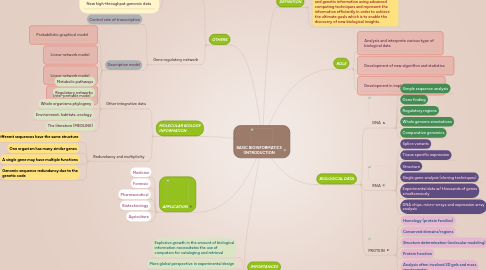
1. APPLICATION
1.1. Medicine
1.2. Forensic
1.3. Pharmaceutical
1.4. Biotechnology
1.5. Agriculture
2. IMPORTANCES
2.1. Explosive growth in the amount of biological information necessitates the use of computers for cataloging and retrieval
2.2. More global perspective in experimental design
2.3. Data-mining
2.4. Uncovering phylogenetic relationships and evolutionary patterns
3. MOLECULAR BIOLOGY INFORMATION
3.1. Other integrative data
3.1.1. Metabolic pathways
3.1.2. Regulatory networks
3.1.3. Whole organisms phylogeny
3.1.4. Environment, habitats, ecology
3.1.5. The literature (MEDLINE)
3.2. Redundancy and multiplicity
3.2.1. Different sequences have the same structure
3.2.2. One organism has many similar genes
3.2.3. A single gene may have multiple functions
3.2.4. Genomic sequence redundancy due to the genetic code
4. OTHERS
4.1. Cellular network
4.1.1. Interaction of genes and their products
4.1.2. New high-throughput genomic data
4.2. Gene regulatory network
4.2.1. Control rate of transcription
4.2.2. Descriptive model
4.2.2.1. Probabilistic graphical model
4.2.2.2. Linear network model
4.2.2.3. Linear network model
4.2.2.4. Inter-pretable model
5. DEFINITION
5.1. The Field of science in which biology,computer science, and information technology merge into a single decipline to gather,store,analyze and integrate biologycal and genetic information using advanced computing techniques and represent the information efficiently in order to achieve the ultimate goals which is to enable the discovery of new biological insights.
6. ROLE
6.1. Analysis and interprete various type of biological data
6.2. Development of new algorithm and statistics
6.3. Development in implementation of tools
7. BIOLOGICAL DATA
7.1. DNA
7.1.1. Simple sequence analysis
7.1.2. Gene finding
7.1.3. Regulatory regions
7.1.4. Whole genome annotations
7.1.5. Comparative genomics
7.2. RNA
7.2.1. Splice variants
7.2.2. Tissue specific expression
7.2.3. Structure
7.2.4. Single gene analysis (cloning techniques)
7.2.5. Experimental data w/ thousands of genes simultaneously
7.2.6. DNA chips, micro-arrays and expression array analysis
7.3. PROTEIN
7.3.1. Homology (protein families)
7.3.2. Conserved domains/regions
7.3.3. Structure determination (molecular modeling)
7.3.4. Protein function
7.3.5. Analysis often involved 2D gels and mass spectrometry

